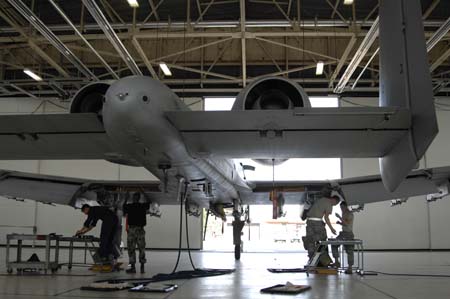Air Comba t Command has 56 of the 130 A-10 Warthogs undergoing special inspection for increased fatigue cracking, causing some concern about meeting requirements for US Central Command’s ongoing operations in Iraq and Afghanistan areas of responsibility. However, Maj. David Ruth, with the ACC A-10 Weapons System Team, maintains the command has “some capability within … the A-10 fleet to meet AOR commitments.” There are some 350 A-10s service-wide, including those in training, test, and routine maintenance status. ACC’s A-10 maintenance crews began their inspections early Oct. 3, the day USAF announced the new technical-compliance order, pulling the affected aircraft off the flying schedule, according to Lt. Col. David Trucksa, ACC chief of flight management. He added, “ACC maintainers will never provide an airplane to a pilot that is known to be unsafe; it will meet all safety standards.” Air Force Material Command engineers have been analyzing fatigue testing data for years on the portion of USAF’s A-10 fleet that have so-called thin-skin wings, Ruth said, noting that the program to begin replacing those wings begins in 2010 and will run through 2016. However, recent depot repair work showed a propensity for some of the aircraft to develop more critical cracks that must receive immediate repair. Once they identify a problem aircraft, ACC officials are working with AFMC experts to develop repair timelines based on the location, size, and orientation of the cracks. (ACC report by MSgt. Steven Goetsch)
t Command has 56 of the 130 A-10 Warthogs undergoing special inspection for increased fatigue cracking, causing some concern about meeting requirements for US Central Command’s ongoing operations in Iraq and Afghanistan areas of responsibility. However, Maj. David Ruth, with the ACC A-10 Weapons System Team, maintains the command has “some capability within … the A-10 fleet to meet AOR commitments.” There are some 350 A-10s service-wide, including those in training, test, and routine maintenance status. ACC’s A-10 maintenance crews began their inspections early Oct. 3, the day USAF announced the new technical-compliance order, pulling the affected aircraft off the flying schedule, according to Lt. Col. David Trucksa, ACC chief of flight management. He added, “ACC maintainers will never provide an airplane to a pilot that is known to be unsafe; it will meet all safety standards.” Air Force Material Command engineers have been analyzing fatigue testing data for years on the portion of USAF’s A-10 fleet that have so-called thin-skin wings, Ruth said, noting that the program to begin replacing those wings begins in 2010 and will run through 2016. However, recent depot repair work showed a propensity for some of the aircraft to develop more critical cracks that must receive immediate repair. Once they identify a problem aircraft, ACC officials are working with AFMC experts to develop repair timelines based on the location, size, and orientation of the cracks. (ACC report by MSgt. Steven Goetsch)
As with previous stealth aircraft unveilings, the Air Force’s imagery of the F-47 Next-Generation Air Dominance fighter has been doctored to keep adversaries guessing about its true shaping and design philosophy.